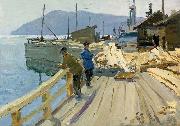 |
Anatoli Ilych Vasiliev -- Click Here
|
|
Anatoli Ilych Vasiliev (Russian: 18 March 1917, Petrograd (former Saint Petersburg), Russian Empire e June 4, 1994, Saint Petersburg, Russian Federation) was a Russian and Soviet realist painter, who lived and worked in Leningrad. He was a member of the Saint Petersburg Union of Artists (before 1992 named as the Leningrad branch of Union of Artists of Russian Federation), and regarded as one of the representatives of the Leningrad school of painting, most famous for his historical paintings and etudes done from nature.
|
|
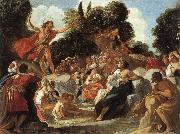 |
Anastagio Fontebuoni -- Click Here
|
|
Firenze 1571 -1626 |
|
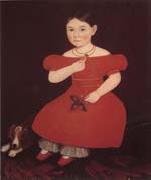 |
Amy Philip -- Click Here
|
|
1788-1865,is a British actress. She is best known for her role as Jessica Arnold in the BBC school drama, Grange Hill, which she acted between 1994 and 1998. In Grange Hill, Amy character was from a middle-class family and was sent to Grange Hill from an exclusive girls school when her father business fell on hard times. She quickly adapted to life at Grange Hill and won a firm following among male fans. In 1996, viewers saw the previously feisty Jessica become bedridden with chronic fatigue syndrome (or M.E. as the condition was then popularly known). Simcock appeared in just the first four episodes of the 1996 series, with Jessica sent to the USA to recuperate. Despite returning to Grange Hill as an integral part of the 1997 series, where Jessica would cause a stir as editor of the school magazine, Simcock appeared in just two episodes of the 1998 series, the explanation being that Jessica had left Grange Hill in favour of sixth form college. In September 1997, Simcock appeared in the CITV comedy drama Knight School as Lady Elizabeth de Gossard, having now changed her professional name to Amy Phillips. Post-Grange Hill, Phillips has continued to make regular occasional appearances in various TV shows, the most notable being as Beth Partridge in the BBC series Rescue Me. She has also appeared in the Hollywood movie The Freediver. |
|
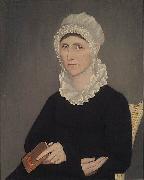 |
Ammi Phillips -- Click Here
|
|
(1788-1865), a self-taught New England portrait painter, is regarded as one of the most important folk artists of his era.
Phillips was born in Colebrook, Connecticut, and began painting portraits as early as 1810. He worked as an itinerant painter in Connecticut, Massachusetts, and New York for five decades.
In 1924, a group of portraits of women, shown leaning forward in three-quarter view and wearing dark dresses, were displayed in an antique show in Kent, Connecticut. The anonymous painter of these strongly colored works, which dated from the 1830s, became known as the "Kent Limner," after the locality where they had come to light.
Stylistically distinct from those of the "Kent Limner," a second group of early-19th-century paintings emerged after 1940 in the area near the Connecticut?CNew York border. Attributed at the time to an unknown "Border Limner," these works, dating from the period 1812?C1818, were characterized by soft pastel hues, as seen in the portrait of Harriet Leavens, now in the Fogg Art Museum, Harvard University.
It was not until 1968 that Ammi Phillips's identity as the painter of both groups of portraits was established. Additional works were identified, showing the artist's transition from the delicate coloration of the Border period to the bold and somber works that followed. |
|
 |
AMMANATI, Bartolomeo -- Click Here
|
|
Italian Mannerist Sculptor, 1511-1592
Italian sculptor and architect. He was a major figure in Italian art in the second and third quarters of the 16th century. His extensive travels in north and central Italy gave him an unequalled understanding of developments in architecture and sculpture in the era of Mannerism. His style was based inevitably on the example of Michelangelo but was modified by the suaver work of Jacopo Sansovino. In both sculpture and architecture Ammanati was a highly competent craftsman, and his masterpieces, the tombs of Marco Mantova Benavides and two members of the del Monte family, the Fountains of Juno and Neptune and the courtyard of the Palazzo Pitti, are among the finest works of the period. |
|
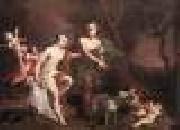 |
AMIGONI, Jacopo -- Click Here
|
|
Italian Rococo Era Painter, ca.1682-1752
He was born in Naples or Venice. Amigoni initially painted both mythological and religious scenes; but as the panoply of his patrons expanded northward, he began producing many parlour works depicting gods in sensuous languor or games. His style influenced Giuseppe Nogari. Among his pupils were Charles Joseph Flipart, Michelangelo Morlaiter, Pietro Antonio Novelli, Joseph Wagner, and Antonio Zucchi.
Starting in 1717, he is documented as working in Bavaria in the Castle of Nymphenburg (1719); in the castle of Schleissheim (1725-1729); and in the Benedictine abbey of Ottobeuren. He returned to Venice in 1726. His Arraignment of Paris hangs in the Villa Pisani at Stra. From 1730 to 1739 he worked in England, in Pown House, Moor Park and in the Theatre of Covent Garden. From there, he helped convince Canaletto to travel to England by telling him of the ample patronage available.
From his travel to Paris in 1736, he met the celebrated castrato named Farinelli. Later in Madrid, he was to paint a self-portrait with the singer and entourage. He also encountered the painting of François Lemoine and Boucher.
In 1739 he returned to Italy, perhaps to Naples and surely to Montecassino, in whose Abbey existed two canvases (destroyed during World War II). Until 1747, he travelled to Venice to paint for Sigismund Streit, for the Casa Savoia and other buildings of the city. In 1747 he left Italy and established himself in Madrid. There he became court painter to Ferdinand VI of Spain and director of the Royal Academy of Saint Fernando. He died in Madrid. |
|
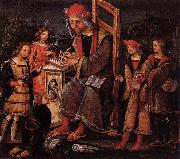 |
Amico Aspertini -- Click Here
|
|
(c. 1474 - 1552) is an Italian Renaissance painter whose complex, eccentric, and eclectic style anticipates Mannerism. He is considered among the first of the Bolognese School of painting.
He was born in Bologna to a family of painters (Guido Aspertini and Giovanni Antonio Aspertini, his father), and studied under masters such as Lorenzo Costa and Francesco Francia. He is briefly documented in Rome between 1500 - 1503, returning to Bologna and painting in a style influenced by Pinturicchio. In Bologna in 1504, he joined Francia and Costa in painting frescoes for the newly restored Oratory of Santa Cecilia in San Giacomo Maggiore, a work commissioned by Giovanni II Bentivoglio.
In 1507-09, he painted a fresco cycle in San Frediano in Lucca. Asperini painted in 1508-1509 the splendid frescoes in the Chapel of the Cross in the Basilica di San Frediano in Lucca. Aspertini was also one of two artists chosen to decorate a triumphal arch for the entry into Bologna of Pope Clement VII and Emperor Charles V in 1529.
|
|
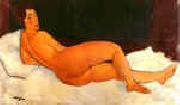 |
Amedeo Modigliani -- Click Here
|
|
Italian Expressionist Painter and Sculptor, 1884-1920
Amedeo Clemente Modigliani (July 12, 1884 ?C January 24, 1920) was an Italian artist of Jewish heritage, practicing both painting and sculpture, who pursued his career for the most part in France. Modigliani was born in Livorno (historically referred to in English as Leghorn), in northwestern Italy and began his artistic studies in Italy before moving to Paris in 1906. Influenced by the artists in his circle of friends and associates, by a range of genres and art movements, and by primitive art, Modigliani's œuvre was nonetheless unique and idiosyncratic. He died in Paris of tubercular meningitis, exacerbated by poverty, overworking, and an excessive use of alcohol and narcotics, at the age of 35. |
|
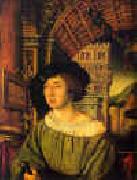 |
Ambrosius Holbein -- Click Here
|
|
1494-1519
German
Ambrosius Holbein Gallery
Ambrosius Holbein (c. 1494 ?C c. 1519) was a German and Swiss artist in painting, drawing and printmaking. He was the elder brother, by about three years, of Hans Holbein the Younger and like his brother was born in Augsburg (which today is in Bavaria, but then was a free imperial city), a center of art, culture and trade at that time. His father Hans Holbein the Elder was a pioneer and leader in the transformation of German art from the Gothic to the Renaissance style. In his studio both his sons, Ambrosius and Hans, received their first painting lessons as well as the an introduction to the crafts of the goldsmith, jeweller and printmaker.
Portrait of a Boy with Blond Hair, 1516, BaselIn 1515 Ambrosius lived in the Swiss town of Stein am Rhein, where he helped a Schaffhausen painter named Thomas Schmid with the murals in the main hall of the St George monastery. The next year saw Ambrosius, as well as his brother Hans, in Basel, where he initially worked as a journeyman in Hans Herbster??s studio. In 1517 he was enrolled in a register of the Basel painters' guild and in 1518 he was naturalized as a citizen there.
The Portrait of a Boy with Blond Hair and its companion, the Portrait of a Boy with Brown Hair, are among Ambrosius?? best works of this period. Both are nowadays in the Basel Kunstmuseum.
Ambrosius Holbein ranks among the most important of Basel??s illustrators and prominent „small formats?? artists. |
|
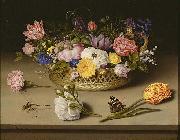 |
Ambrosius Bosschaert -- Click Here
|
|
(Antwerp, January 18, 1573?CThe Hague, 1621) was a still life painter of the Dutch Golden Age.He started his career in Antwerp, but spend most of it in Middelburg (1593?C1613), where he became dean of the painters' guild. He later worked in Amsterdam (1614), Bergen op Zoom (1615?C1616), Utrecht (1616?C1619), and Breda (1619). He specialised in painting still lifes with flowers. In 1587, Ambrosius Bosschaert moved from Antwerp to Middelburg with his family because of the threat of religious persecution. At the age of twenty-one, he joined the cityes Guild of Saint Luke. Not long after, Bosschaert had established himself as a leading figure in the fashionable floral painting genre.
|
|
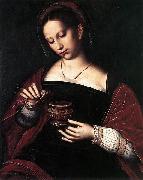 |
Ambrosius Benson -- Click Here
|
|
(c.1495/1500, Ferrara or Milan - 1550, Flanders) was an Italian painter who became a part of the Northern Renaissance.
While many surviving paintings have been attributed, there is very little known of him from records, and he tended not to sign his work. He is believed to be responsible for mainly religious art, but also painted portraits on commission. He sometime painted from classical sources, often setting the figures in modern-dress, or a contemporary domestic setting. In his lifetime he was successful; he had a large workshop, his work was sold internationally and he was especially popular in Spain.
Benson became popular as a source for pastiche with 19th century painters, who are sometimes known as the "followers of Benson". In particular his many variations of the Magdalen and Sibilla Persica, were further copied and became popular with contemporary buyers. Many have retained their relative value and held in the National Gallery, London and command high prices at Sotheby's
|
|
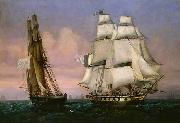 |
Ambroise-Louis Garneray -- Click Here
|
|
(19 February 1783 - 11 September 1857) was a French corsair, painter and writer. He served under Robert Surcouf and Jean-Marie Dutertre, and was held prisoner by the British for eight years.
Garneray was born in Paris (on Rue Saint-Andre-des-arts, in the Latin Quarter) on 19 February 1783. He was the elder son of Jean-François Garneray (1755-1837), painter of the king, who was pupil of Jacques-Louis David. At thirteen, he joined the Navy as a seaman, encouraged by his cousin, Beaulieu-Leloup, commander of the frigate Forte ("the Stout one"). Garneray sailed from Rochefort to the Indian Ocean with the frigate division under Sercey, to which the Forte belonged.
Garneray took part in the various campaigns of Sercey division and witnessed the hardship it met in the battle against Arrogant and Victorious. He then served in 1798 on the corvette Brûle Gueule ("Mouth burner"), which patrolled with the frigate Preneuse ("the Taker"). Returning from this campaign, the Brûle Gueule and Preneuse were chased by a British squadron comprising two ships of the line, one frigate and one corvette; the French flew into a creek near Black River whose shallow waters prevented the British from pursuing. The next day, the British squadron attacked; the French had established strong defensive positions by installing the unusable batteries of their ships ashore, and repelled the British squadron.
In 1799, Garneray was promoted to quartermaster and "first painter of the edge" on the Preneuse under captain Jean-Marthe-Adrien l'Hermite. The frigate was the last French official force in the Indian Ocean. This patrol went into trouble, in spite of an exceptional combat against the British ship of the line the Jupiter. Returning to Mauritius, her crew suffered from scurvy, and the Preneuse had to be kept quarantined and had to return to the British forces making the blockade of the island. Garneray escaped captivity by regaining the coast with the stroke. In spite of the disaster, Garneray kept longstanding admiration and friendship for to Lhermitte, whom he would continue to visit until his death 1826.
Garneray: Capture of Kent by SurcoufFor lack of official ships, Garneray joined the Confiance ("the Trust") of Robert Surcouf as an ensign, from April at December 1800. He took part in the capturing and boarding the Kent in October 1800. It was the only time where Garneray made money as a sailor. Upon returning from patrol, he invested his share in a slave trading ship, l'Union, on which he was a first mate.
He sailed on various trading ships during the peace of Amiens, after which he served aboard the Pinson ("the Finch"), a cutter based in Île Bourbon. He replaced the commander when he died, and was shipwrecked shortly thereafter. He then served on the corsair Tigre du Bengale and eventually on the frigate Atalante attached to the squadron of Linois. He later served on the Belle Poule ("beautiful chick"), and was aboard when she was captured by the British in March 1806. Wounded, Garneray was led in England and spent the eight following years on prison hulks off Portsmouth (on the Protee, the Couronne ("Crown") and the Vengeance. He was able to improve his standard of living by selling paintings to a British merchant.
A statement attributed to him goes: "But for piracy, I believe that I practiced about all kinds of navigation".
|
|
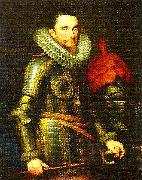 |
ambrogio spinola -- Click Here
|
|
Ambrogio Spinola var italienare, fodd i Genua 1569 han utvecklades snabbt till en av tidens framsta legoknektsanforare eller kondottiarer |
|
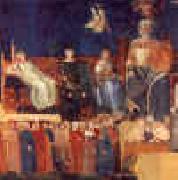 |
Ambrogio Lorenzetti -- Click Here
|
|
Italian Byzantine Style Painter, ca.1290-1348
Ambrogio Lorenzetti (or Ambruogio Laurati; c. 1290 ?C June 9, 1348) was an Italian painter of the Sienese school. He was active between approximately from 1317 to 1348. His elder brother was the painter Pietro Lorenzetti.
His work shows the influence of Simone Martini, although more naturalistic. The earliest dated work of the Sienese painter is a Madonna and Child (1319, Museo Diocesano, San Casciano). His presence was documented in Florentine up until 1321. He would return there after spending a number of years in Siena.
The frescoes on the walls of the Hall of the Nine (Sala dei Nove) or Hall of the Peace (Sala della Pace) in the Palazzo Pubblico of Siena are one of the masterworks of early renaissance secular painting. The "nine" was the oligarchal assembly of guild and monetary interests that governed the republic. Three walls are painted with frescoes consisting of a large assembly of allegorical figures of virtues in the Allegory of Good Government . In the other two facing panels, Ambrogio weaves panoramic visions of Effects of Good Government on Town and Country, and Allegory of Bad Government and its Effects on Town and Country (also called "Ill-governed Town and Country"). The better preserved "well-governed town and country" is an unrivaled pictorial encyclopedia of incidents in a peaceful medieval "borgo" and countryside.
The first evidence of the existence of the hourglass can be found in one of his paintings.
Like his brother, he is believed to have died of bubonic plague 1348. Giorgio Vasari includes a biography of Lorenzetti in his Lives. |
|
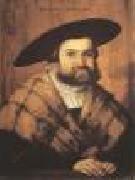 |
AMBERGER, Christoph -- Click Here
|
|
German Painter, ca.1500-1562
German painter and draughtsman. His family came from the Upper Palatinate. He served his apprenticeship in Augsburg, probably with Leonhard Beck, whose daughter Barbara he married. He became a master on 15 May 1530 but rarely signed his work. He was in northern Italy and Venice c. 1525-7. His full-length pendant portraits of a husband and wife (both 1525; Vienna, Ksthist. Mus.) show Venetian influence, and the portrait of Anton Welser (1527; priv. col., see 1980 exh. cat., p. 98) is in the Italian style. According to Sandrart, during the Imperial Diet of 1530 in Augsburg Amberger painted a portrait of Emperor Charles V to the Emperor's satisfaction, but the surviving work (Berlin, Gem?ldegal.) dates from 1532, based on the age given. In the decades that followed, Amberger was the favourite portrait painter of ambitious merchant families, such as the Fugger, who belonged to guilds but were connected with the nobility by family or marriage ties. |
|
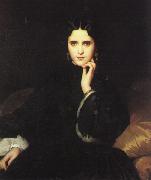 |
Amaury-Duval, Eugene-Emmanuel -- Click Here
|
|
French Academic Painter, 1808-1885 |
|
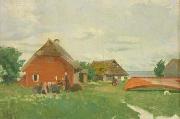 |
Amandus Adamson -- Click Here
|
|
(12 November 1855, Uuga-Rätsepa, near Paldiski -26 June 1929, Paldiski) was an Estonian sculptor and painter.
Born into a seafaring family, Adamson excelled in wood carving as a child. He moved to St. Petersburg in 1875 to study at the Imperial Academy of Arts under Alexander Bock. After graduation he continued to work as a sculptor and teacher in St. Petersburg, with an interruption from 1887 through 1891 to study in Paris and Italy, influenced by the French sculptors Jules Dalou and Jean-Baptiste Carpeaux.
Adamson produced his best-known work in 1902. His Russalka Memorial, dedicated to the 177 lost sailors of the Ironclad warship Russalka, features a bronze angel on a slender column. The other work is architectural. His four allegorical bronzes for the Eliseyev department store in St. Petersburg (for architect Gavriil Baranovsky), and the French-style caryatids and finial figures for the Singer House (for architect Pavel Suzor) are major components of the "Russian Art Nouveau" visible along Nevsky Prospekt. |
|
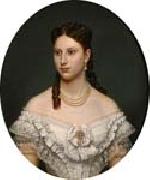 |
Amalia Lindegren -- Click Here
|
|
(22 May 1814 in Stockholm, died 27 December 1891 in Stockholm, was a Swedish artist and painter, from 1856 a member of the Royal Swedish Academy of Arts.
At the age of three, she was left an orphan after her mothers death and adopted by the widow of her alleged biological father, Benjamin Sandel. Her position as a child was somewhat humiliating, as a form of charity object for the upper classes, and in her later work, her paintings of sad little girls is believed to be inspired by her childhood.
Her drawings made the artist and art teacher Carl Gustaf Qvarnström include her as one of the four women accepted as students at the academy in 1849, and in 1850, she became the first woman given an art scholarship from the academy to study art in Paris, which she did at the studies of Coignet and Tissier; she also studied in D??sseldorf and Menich before she returned to Sweden in 1856, were she was elected to the academy |
|
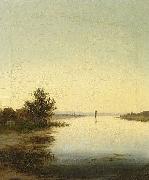 |
Amalia del Pilar de Borbon -- Click Here
|
|
painted Abendliche Chiemseelandschaft in |
|
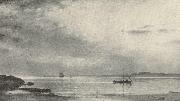 |
Amaldus Clarin Nielsen -- Click Here
|
|
(23 May 1838 - 10 December 1932) was a Norwegian painter.
He was born in Halse as a son of shipmaster and merchant Niels Clemetsen Nielsen (1795 - 1845) and his wife Andrea Marie Møller (1802 - 1866). He grew up in Mandal in Vest-Agder county, Norway. He lived most of his childhood and adolescence without a father. He received some tuition from a traveling drawing teacher and traveled to Copenhagen to study in 1854
|
|
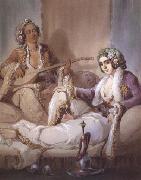 |
Amadeo Preziosi -- Click Here
|
|
Italian Painter, 1816-1882 |
|
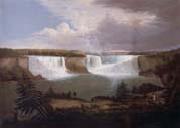 |
Alvan Fisher -- Click Here
|
|
American Painter, 1792-1863, American painter. Soon after he left the tutelage of John Ritto Penniman (c. 1782-1841), he began to paint genre landscapes such as Winter in Milton, Massachusetts (1815; Montclair, NJ, A. Mus.), which depicts a man on a horse-drawn sleigh enjoying the beauty of a fresh New England snowfall. |
|
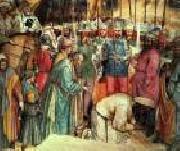 |
ALTICHIERO da Zevio -- Click Here
|
|
Italian Gothic Era Painter, ca.1330-1390
Altichiero da Verona (also called Aldighieri da Zevio; c. 1330 ?C c. 1390) was an Italian painter of the Gothic style. A follower of Giotto, Altichiero is credited with founding the Veronese school. He worked in Verona and Padua ?? works by him survive in the church of Sant'Anastasia in Verona and in the basilica of Sant'Antonio and the Oratorio di San Giorgio in Padua (where the credit for the work has been generally shared with Jacopo d'Avanzi, about whom little is known).
Altichiero was probably born somewhere near Zevio. He became an important member of the della Scala's household, and around 1364 painted a series of frescoes based upon Flavius Josephus's The Wars of the Jews at the della Scala palace of Sala del Podest??.
There are frescoes by him in the Basilica of Saint Anthony of Padua. In conjunction with D'Avanzo Veronese, he frescoed the chapel of St. James for which he was paid 792 ducats. The first seven frescoes on the life of St. James the Elder were by Altichiero. |
|
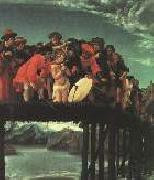 |
ALTDORFER, Albrecht -- Click Here
|
|
German Northern Renaissance Painter, ca.1480-1538
Albrecht Altdorfer (c. 1480 near Regensburg ?C 12 February 1538 in Regensburg) was a German painter, printmaker and architect of the Renaissance era, the leader of the Danube School in southern Germany, and a near-contemporary of Albrecht D??rer. He is best known as a significant pioneer of landscape in art.
He most often painted religious scenes, but is mainly famous as the first frequent painter of pure landscape, and also compositions dominated by their landscape. Taking and developing the landscape style of Lucas Cranach the Elder, he shows the hilly landscape of the Danube valley with thick forests of drooping and crumbling firs and larches hung with moss, and often dramatic colouring from a rising or setting sun. His Landscape with footbridge (National Gallery, London) of 1518-20 is claimed to be the first pure landscape in oil. [1] He also made many fine finished drawings, mostly landscapes, in pen and watercolour. His best religious scenes are intense, sometimes verging on the expressionistic, and often depict moments of intimacy between Christ and his mother, or others. His most famous religious artwork is the The Legend of St. Sebastian and the Passion of Christ that decorated the altar in the St. Florian monastery in Linz, Austria. He often distorts perspective to subtle effect. His donor figures are often painted completely out of scale with the main scene, as in paintings of the previous centuries. He also painted some portraits; overall his painted oeuvre was not large. |
|
 |
ALSLOOT, Denis van -- Click Here
|
|
Flemish painter (b. 1570, Mechlin, d. 1628, Bruxelles)
He initially painted using the style of Gillis van Coninxloo, but after 1610 gradually developed a style of his own. This style can be seen in paintings such as The feast of the Ommegang (Museo del Prado, Madrid) and Procession to Mary at the Zavel in Brussels (Victoria and Albert Museum, London).
At the beginning of the 17th century, in either 1600 or 1606, his career rose when he served as court painter to Albert and Isabella.
Hendrick de Clerck painted sometimes the people in his works.
Van Alsloot's work can be regarded as a precursor to modern Landscape art. |
|
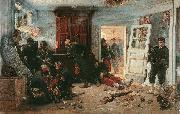 |
Alphonse-Marie-Adolphe de Neuville -- Click Here
|
|
(31 May 1835 - 18 May 1885) was a French Academic painter who studied under Eugene Delacroix. His dramatic and intensely patriotic subjects illustrated episodes from the Franco-Prussian War, the Crimean War, the Zulu War and portraits of soldiers. Some of his works have been collected by the Hermitage Museum in St. Petersburg and by the Metropolitan Museum in New York.
The Last Cartridges, 1873
The Defence of Rorke's Drift, oil on canvas painting by Alphonse-Marie-Adolphe de Neuville, 1880, Art Gallery of New South Wales. This incident occurred on 22 January 1879, in the Anglo-Zulu War.
La bataille de VillersexelHe was born to wealthy parents at Saint-Omer, Pas-de-Calais. From school he went to college, where he took his degree of bachelier -lettres. In spite of the opposition of his family he entered the naval school at Lorient, and it was there, in 1856, that his artistic instincts first declared themselves.
After being discouraged by several painters of repute, he was admitted to work in François-Edouard Picot's studio. He did not remain there long, and he was painting by himself when he produced his first picture, The Fifth Battalion of Chasseurs at the Gervais Battery (Malakoff). In 1860 Neuville painted an Episode of the taking of Naples by Garibaldi for the Artists' Club in the rue de Provence, and sent to the Paris Salon in 1861 The Guard Chasseurs in the Trenches of the Mamelon Vert.
He participated in illustrating the Hetzel editions of Twenty Thousand Leagues Under the Sea. He also illustrated Le Tour du monde and Guizot's History of France. At the same time he painted a number of remarkable pictures: The Attack in the Streets of Magenta by Zouaves and the Light Horse (1864), A Zouave Sentinel (1865), The Battle of San Lorenzo (1867), and Dismounted Cavalry crossing the Tchernaia (1869). In these he showed peculiar insight into military life, but his full power was not reached until after the Franco-Prussian War. He then aimed at depicting in his works the episodes of that war, and began by representing the Bivouac before Le Bourget (1872). His fame spread rapidly, and was increased by The Last Cartridges (1873), memorializing an episode involving the Blue Division of the French marines, in which it is easy to discern the vast difference between the conventional treatment of military subjects, as practised by Horace Vernet, and that of a man who had lived the life that he painted.
In 1874 the Fight on a Railroad was not less successful, and was followed by the Attack on a House at Villersexel (1875) and the Railway Bridge at Styring (1877). In 1878 the painter exhibited (not at the Great Exhibition) Le Bourget, the Surprise at Daybreak, The Intercepted Despatch-bearer, and a considerable number of drawings. He also exhibited in London some episodes of the Zulu War. Fifty thousand people paid to see his impression of The Defence of Rorke's Drift (1880), which the infant Art Gallery of New South Wales in Sydney paid a large sum to acquire.
In 1881 he was made an officer of the Legion d'honneur for The Cemetery of Saint-Privat and The Despatch-bearer and the "Huns in the Battle of Chalon." During these years Neuville was at work with Édouard Detaille on an important though less artistic work, The Panorama of Rezonville. Neuville died in Paris on May 18, 1885. At the sale of his works the state purchased for the Palais du Luxembourg the Bourget and the Attack on a Barricaded House, with a water-color The Parley, and a drawing of a Turco in Fighting Trim.
|
|
 |
Alphonse Mucha -- Click Here
|
|
1860-1939
Czech
Alfons Maria Mucha was born in the town of Ivančice, Moravia (today's region of Czech Republic). His singing abilities allowed him to continue his education through high school in the Moravian capital of Brno, even though drawing had been his first love since childhood. He worked at decorative painting jobs in Moravia, mostly painting theatrical scenery, then in 1879 moved to Vienna to work for a leading Viennese theatrical design company, while informally furthering his artistic education. When a fire destroyed his employer's business in 1881 he returned to Moravia, doing freelance decorative and portrait painting. Count Karl Khuen of Mikulov hired Mucha to decorate Hrusovany Emmahof Castle with murals, and was impressed enough that he agreed to sponsor Mucha's formal training at the Munich Academy of Fine Arts.
Poster of Maude Adams as Joan of Arc, 1909Mucha moved to Paris in 1887, and continued his studies at Academie Julian and Academie Colarossi while also producing magazine and advertising illustrations. Around Christmas 1894, Mucha happened to drop into a print shop where there was a sudden and unexpected demand for a new poster to advertise a play starring Sarah Bernhardt, the most famous actress in Paris, at the Theatre de la Renaissance. Mucha volunteered to produce a lithographed poster within two weeks, and on 1 January 1895, the advertisement for Gismonda appeared on the streets of the city. It was an overnight sensation and announced the new artistic style and its creator to the citizens of Paris. Bernhardt was so satisfied with the success of that first poster that she entered into a 6 years contract with Mucha.
Mucha produced a flurry of paintings, posters, advertisements, and book illustrations, as well as designs for jewellery, carpets, wallpaper, and theatre sets in what was initially called the Mucha Style but became known as Art Nouveau. Mucha's works frequently featured beautiful healthy young women in flowing vaguely Neoclassical looking robes, often surrounded by lush flowers which sometimes formed haloes behind the women's heads. In contrast with contemporary poster makers he used paler pastel colors. The 1900 Universal Exhibition in Paris diffused the "Mucha style" internationally. He decorated the Bosnia and Herzegovina Pavilion and collaborated in the Austrian one. His Art Nouveau style was often imitated. However, this was a style that Mucha attempted to distance himself from throughout his life; he insisted always that, rather than adhering to any fashionable stylistic form, his paintings came purely from within and Czech art. He declared that art existed only to communicate a spiritual message, and nothing more; hence his frustration at the fame he gained through commercial art, when he wanted always to concentrate on more lofty projects that would ennoble art and his birthplace.
|
|
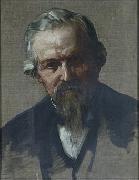 |
Alphonse Legros -- Click Here
|
|
Alphonse Legros (8 May 1837 - 8 December 1911), painter, etcher and sculptor was born in Dijon. His father was an accountant, and came from the neighbouring village of Veronnes. Young Legros frequently visited the farms of his relatives, and the peasants and landscapes of that part of France are the subjects of many of his pictures and etchings. He was sent to the art school at Dijon with a view to qualifying for a trade, and was apprenticed to Maître Nicolardo, house decorator and painter of images. In 1851 Legros left for Paris to take another situation; but passing through Lyon he worked for six months as journeyman wall-painter under the decorator Beuchot, who was painting the chapel of Cardinal Bonald in the cathedral.
|
|
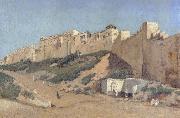 |
Alphonse Asselbergs -- Click Here
|
|
Belgian, 1839-1916 |
|
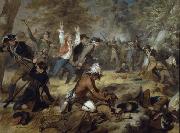 |
Alonzo Chappel -- Click Here
|
|
Alonzo Chappel (1828 - 1887) was an American painter, best known for paintings depicting personalities and events from the American Revolution and early 19th-century American history.
Chappel was born in New York City and died in Middle Island, New York. |
|
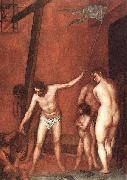 |
Alonzo Cano -- Click Here
|
|
Alonzo Cano or Alonso Cano (19 March 1601 - 3 September 1667) was a Spanish painter, architect and sculptor born in Granada. He learned architecture from his father, Miguel Cano;painting in the academy of Juan del Castillo, and from Francisco Pacheco the teacher of Velezquez; and sculpture from Juan Martenez Montañes. As a sculptor, his most famous works are the Madonna and Child in the church of Lebrija (also called Nebrija), and the colossal figures of San Pedro and San Pablo.
He was made first royal architect, painter to Philip IV, and instructor to the prince, Balthasar Charles, Prince of Asturias. The King gave him the church preferment of a canonof the Granada Cathedral (1652), in order to take up a position as chief architect of the cathedral, where his main achievement in architecture was the façade, designed at the end of his life and erected to his design after his death.[citation needed]
Ideal portrait of a Spanish King.He was notorious for his ungovernable temper; and it is said that once he risked his life by committing the then capital offence of dashing to pieces the statue of a saint, when in a rage with the purchaser who begrudged the price he demanded.[1] According to another story, he found his house robbed after coming home one evening, his wife murdered, and his Italian servant fled. Notwithstanding the presumption against the fugitive, the magistrates condemned Cano, because he was of a jealous temper. Upon this he fled to Valencia, but afterwards returned to Madrid, where he was put to the torture, which he endured without incriminating himself, and the king received him into favour.
After the death of his wife he took Holy Orders as a protection from farther prosecution, but still continued his professional pursuits. He died in 1676. In his last moments, when the priest held to him a crucifix, he told him to take it away; according to the Catholic Encyclopedia, this was because the priest gave the Sacrament to conversos. |
|
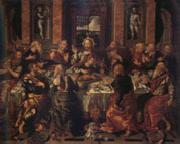 |
Alonso Vazquez -- Click Here
|
|
Spanish
?-1608
was a Spanish sculptor and painter of the Renaissance period. Vazquez was born in Ronda, and learned painting in the school of Arfian at Seville. He passed through the usual apprenticeship of painting "sargas" and at length painted frescoes and oil-pictures. For the Cathedral and the convents of St. Francis and St. Paul, he painted a variety of works, no longer extant. He painted a series of canvases on the life of St. Raymond, for the cloister of the friars of the order of Mercy. Vazquez was one of the artists chosen by the city of Seville to paint the great catafalque erected in the Cathedral, at the time of public mourning for the death of Philip II. He died either in Seville or in Mexico, |
|
 |
Alonso Sanchez Coello -- Click Here
|
|
Alonso Sachez Coello (1531/32 -August 8, 1588) was a portrait painter of the Spanish Renaissance and one of the pioneers of the great tradition of Spanish portrait painting.
Alonso Sachez Coello was born in Benifairode les Valls, near Valencia, and spent his childhood there, until the death of his father when he was around ten years old. He was educated in Portugal at his grandfather's home. Coello's years in Portugal and his family name of Portuguese origin led to a long-standing belief that he was in fact Portuguese. His grandfather (after whom he was named) was in the service of King John III of Portugal who sent the young painter to study with Anthonis Mor (also known as Antonio Moro) in Flanders around 1550. He was under the service of Antoine de Granville, bishop of Arras, learning from Mor. While studying in Flanders, Coello also spent time copying some of Titian's works. |
|
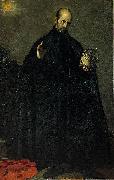 |
Alonso Cano -- Click Here
|
|
(19 March 1601 - 3 September 1667) was a Spanish painter, architect and sculptor born in Granada. He learned architecture from his father, Miguel Cano; painting in the academy of Juan del Castillo, and from Francisco Pacheco the teacher of Velezquez; and sculpture from Juan Martenez Montañ's. As a sculptor, his most famous works are the Madonna and Child in the church of Lebrija (also called Nebrija), and the colossal figures of San Pedro and San Pablo.
He was made first royal architect, painter to Philip IV, and instructor to the prince, Balthasar Charles, Prince of Asturias.The King gave him the church preferment of a canon of the Granada Cathedral (1652), in order to take up a position as chief architect of the cathedral, where his main achievement in architecture was the façade, designed at the end of his life and erected to his design after his death.
Ideal portrait of a Spanish King.He was notorious for his ungovernable temper; and it is said that once he risked his life by committing the then capital offence of dashing to pieces the statue of a saint, when in a rage with the purchaser who begrudged the price he demanded. According to another story, he found his house robbed after coming home one evening, his wife murdered, and his Italian servant fled. Notwithstanding the presumption against the fugitive, the magistrates condemned Cano, because he was of a jealous temper. Upon this he fled to Valencia, but afterwards returned to Madrid, where he was put to the torture, which he endured without incriminating himself, and the king received him into favour.
After the death of his wife he took Holy Orders as a protection from farther prosecution, but still continued his professional pursuits. He died in 1676. In his last moments, when the priest held to him a crucifix, he told him to take it away; according to the Catholic Encyclopedia, this was because the priest gave the Sacrament to conversos.
|
|
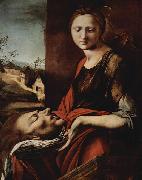 |
Alonso Berruguete -- Click Here
|
|
(Alonso Berruguete) (c. 1488 - 1561) was a Spanish painter, sculptor and architect. He is considered to be the most important sculptor of the Spanish Renaissance, and is known for his emotive sculptures depicting religious ecstasy or torment.
Born in the town of Paredes de Nava, Berrugete studied art under the tutelage of his father, the painter Pedro Berruguete. Following his father's death in 1504, Berruguete travelled to Italy to continue with his study of art, spending most of his time in Florence and Rome. It is here that he studied sculpture under the Italian Master, Michelangelo. His paintings produced in Italy showed a mannerist influence, with his art being compared with contemporaries such as Jacopo Pontormo and Rosso Fiorentino.
Berruguete returned to Spain in 1517, and in 1518, was appointed to the position of court painter and sculptor by Charles V of Spain. From this point in his career forward, Berruguete concentrated on sculpture. Works of his include an altar piece at the Irish college in Salamanca (1529-1533), choir stalls at the Cathedral of Toledo (1539-1543) and a tomb for the Archbishop of Toledo Juan de Tavera at the hospital that Tavera founded, the hospital of St. John the Baptist in Toledo (1552-1561). |
|
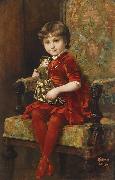 |
Alois Hans Schram -- Click Here
|
|
Alois Hans Schram
(1864 - 1919)
Alois Hans Schram was born in Vienna on August 20th. He was a painter and sculptor of historical subjects, figures, nudes, portraits, scenes with figures, genre scenes, local scenes, interiors with figures, landscapes with figures, urban landscapes, waterscapes and seascapes. |
|
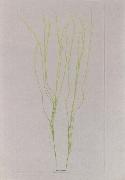 |
Alois Auer von Welsbach -- Click Here
|
|
Wels1813-1869 Vienna |
|
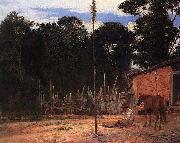 |
Almeida Junior -- Click Here
|
|
(8 May 1850 ?C 13 November 1899) was a Brazilian painter of the 19th century. He is widely regarded as the most important Brazilian realist painter of the 19th century, and a major inspiration for the modernist painters. While most Brazilian academic artists made their fame painting mythological or historical subjects, Almeida Junior would become popular for painting rural figures, especially farmers and the caipira, the countrymen that are a kind of a symbol of the rural areas of the São Paulo state.
While most realist painters used farmers and countrymen as an allegory of workers, Almeida Junior would paint his caipiras mostly on leisure time. He would also produce touching images of upscale landowners. The Bandeirantes, the ruthless explorers of colonial Brazil, would be depicted in the A partida da monção, showing an expedition on the Tiet?? River.
Almeida Junior was born in the city of Itu, then a small town in the state of São Paulo. After becoming a sensation in his town he would be invited to study in the Brazilian Imperial Fine Arts Academy of Rio de Janeiro, but in 1876 would study in France after being granted a scholarship by emperor Pedro II of Brazil in person in the city of Moji-Mirim. He would have Alexandre Cabanel as one of his masters.
He admired the French realist and naturalist painting (a major influence at his work), and, after returning to Brazil in 1882, became of the leading names in Brazilian realist painting.
He was stabbed to death by the husband of his mistress on November 13, 1899 in Piracicaba.
|
|
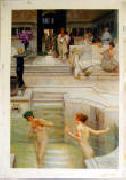 |
Alma-Tadema, Sir Lawrence -- Click Here
|
|
b.Jan. 8, 1836, Dronrijp, Netherlands.
d.June 25, 1912, Wiesbaden, Germany.
Painter and designer of Dutch birth. The son of a notary, Alma-Tadema demonstrated an early artistic ability. In 1852 he entered the Antwerp Academy, where he studied under Gustaf, Baron Wappers, and Nicaise de Keyser. An important influence at this time was Louis De Taye, Professor of Archaeology at the academy and a practising artist. Alma-Tadema lived and worked with De Taye from 1857 to 1859 and was encouraged by him to depict subjects from the early history of France and Belgium. This taste for historical themes increased when Alma-Tadema entered Baron Henri Leys studio in 1859 and began assisting him with his monumental frescoes for the Antwerp Town Hall. While in Leys studio, Alma-Tadema produced several major paintings, for example the Education of the Children of Clovis (1861; ex-Sir John Pender priv. col., see Zimmern, p. 3) and Venantius Fortunatus Reading his Poems to Radagonda (1862; Dordrecht, Dordrechts Mus.), which are characterized by their obscure Merovingian subject-matter, rather sombre colouring and close attention to detail. |
|
 |
ALLORI Alessandro -- Click Here
|
|
Italian Mannerist Painter, 1535-1607
Born in Florence. After the death of his father in 1540 he was brought up and trained in art by a close friend, often referred to as his 'uncle', the mannerist painter Agnolo Bronzino, whose name he sometimes assumed in his pictures. In some ways, Allori is the last of the line of prominent Florentine painters, of generally undiluted Tuscan artistic heritage: Andrea del Sarto worked with Fra Bartolomeo (as well as Leonardo Da Vinci), Pontormo briefly worked under Andrea, and trained Bronzino, who trained Allori. Subsequent generations in the city would be strongly influenced by the tide of Baroque styles pre-eminent in other parts of Italy.
Freedburg derides Allori as derivative, claiming he illustrates "the ideal of Maniera by which art (and style) are generated out of pre-existing art." The polish of figures has an unnatural marble-like form as if he aimed for cold statuary. It can be said of late phase mannerist painting in Florence, that the city that had early breathed life into statuary with the works of masters like Donatello and Michelangelo, was still so awed by them that it petrified the poses of figures in painting. While by 1600 the Baroque elsewhere was beginning to give life to painted figures, Florence was painting two-dimensional statues. Furthermore, in general, with the exception of the Contra Maniera artists, it dared not stray from high themes or stray into high emotion. |
|
 |
ALLORI Cristofano -- Click Here
|
|
Italian Baroque Era Painter, 1577-1621
Allori was born at Florence and received his first lessons in painting from his father, Alessandro Allori, but becoming dissatisfied with the hard anatomical drawing and cold coloring of the latter, he entered the studio of Gregorio Pagani (1558-1605) who was one of the leaders of the late Florentine school, which sought to unite the rich coloring of the Venetians with the Florentine attention to drawing. Allori also appears to have worked under Cigoli.
His pictures are distinguished by their close adherence to nature and the delicacy and technical perfection of their execution. His technical skill is shown by the fact that several copies he made of Correggio's works were thought to be duplicates by Correggio himself. His extreme fastidiousness limited the number of his works. Several specimens are to be seen at Florence and elsewhere.
The finest of his works is his Judith with the Head of Holofernes. It exists in two copies in the Pitti Palace in Florence and in the Queen's Gallery in London. The model for the Judith was his mistress, the beautiful Mazzafirra, who is also represented in his Magdalene; and the head of Holofernes is generally supposed to represent himself. |
|
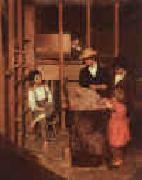 |
Allen Smith -- Click Here
|
|
1810-1890
Allen Smith Galleries |
|
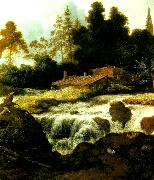 |
allart van everdingen -- Click Here
|
|
Allaert van Everdingen (bapt. 18 June 1621 Alkmaar - buried 8 November 1675, Amsterdam), was a Dutch Golden Age painter and printmaker in etching and mezzotint.
Van Everdingen was the son of a government clerk at Alkmaar. He and his older brothers, the painters Jan and Caesar van Everdingen, according to Arnold Houbraken, were taught by Roelandt Savery at Utrecht. Allaert moved in 1645 to Haarlem, where he studied under Pieter de Molijn, and finally settled about 1657 at Amsterdam, where he died in 1675. |
|
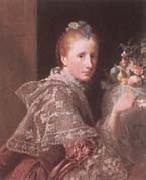 |
Allan Ramsey -- Click Here
|
|
1713-1784
Rococo,Scottish |
|
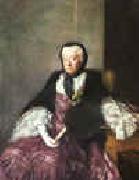 |
Allan Ramsay -- Click Here
|
|
1713-1784
British Allan Ramsay Galleries
Allan Ramsay was born in Edinburgh, Scotland, the eldest son of Allan Ramsay, poet and author of The Gentle Shepherd.
Ramsay's first wife, Anne Bayne, by Ramsay
Ramsay's second wife Margaret Lindsay, by RamsayFrom the age of twenty he studied in London under the Swedish painter Hans Huyssing, and at the St. Martin's Lane Academy; leaving in 1736 for Rome and Naples, where he worked for three years under Francesco Solimena and Imperiali (Francesco Fernandi). On his return in 1738 he first settled in Edinburgh, attracting attention by his head of Duncan Forbes of Culloden and his full-length portrait of the Duke of Argyll, later used on Royal Bank of Scotland banknotes. He later moved to London, where he was employed by the Duke of Bridgewater. His pleasant manners and varied culture, not less than his artistic skill, contributed to render him popular. His only serious competitor was Thomas Hudson, with whom he shared a drapery painter, Joseph van Aken. In 1739 he married his first wife, Anne Bayne, the daughter of a professor of Scots law at Edinburgh, Alexander Bayne of Rires (c.1684?C1737), and Mary Carstairs (1695??C1759). None of their 3 children survived childhood, and she died on 4 February 1743 giving birth to the third of them.
One of his drawing pupils was Margaret Lindsay, eldest daughter of Sir Alexander Lindsay of Evelick and Amelia Murray (granddaughter to David Murray, 5th Viscount of Stormont and sister to the naval officer John Lindsay). He later eloped with her and on 1 March 1752 they married in the Canongate Kirk, Edinburgh, though her father never forgave her for marrying an artist. Ramsay already had to maintain a daughter from his previous marriage as well as his two surviving sisters, but told Sir Alexander that he could provide Margaret with an annual income of £100 which would increase ??as my affairs increase, and I thank God, they are in a way of increasing?? and that his only motive for the marriage was ??my love for your Daughter, who, I am sensible, is entitled to much more than ever I shall have to bestow upon her??. There were three surviving children from their long and happy marriage, Amelia (1755?C1813), Charlotte (1758?C1818?), and John (1768?C1845).
Ramsay and his new wife spent 1754?C1757 together in Italy, going to Rome, Florence, Naples and Tivoli, researching, painting and drawing old masters, antiquities and archaeological sites, and (to earn an income) painting Grand Tourists' portraits. This and other trips to Italy involved more literary and antiquarian research than art. After their return, he was in 1761 appointed to succeed John Shackelton as Principle Painter in Ordinary to George III, beating Hudson to the post; and so fully employed was he on the royal portraits which the king was in the habit of presenting to ambassadors and colonial governors, that he was forced to take advantage of the services of a host of assistants--of whom David Martin and Philip Reinagle are the best known.
He gave up painting in about 1770 to concentrate on literary pursuits, his health shattered by an accidental dislocation of the right arm and his second wife's death in 1782. With unflinching pertinacity, he struggled until he had completed a likeness of the king upon which he was engaged at the time, and then started for his beloved Italy, leaving behind him a series of fifty royal portraits to be completed by his assistant Reinagle. For several years he lingered in the south, his constitution finally broken. He died at Dover on 10 August 1784. |
|
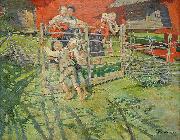 |
Allan osterlind -- Click Here
|
|
painted Lekande barn - sommar pa fabodvallen in 1890 |
|
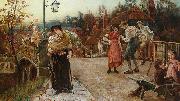 |
Alice Mary Havers -- Click Here
|
|
(1850-1890) - Painter |
|
|
|
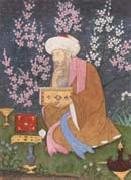 |
Ali of Golconda -- Click Here
|
|
the period of 1465-1535
|
|
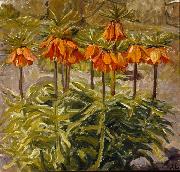 |
Alhed Larsen -- Click Here
|
|
Alhed Maria Larsen nee Warberg (7 April 1872, Heden near Faaborg - 31 August 1927, Odense), the wife of Johannes Larsen, was one of the Fynboerne or "Funen Artists" who lived and worked on the Danish island of Funen.
Alhed Larsen was the daughter of Albrecht Christoffer Warberg, who managed the Erikshåb estate in the south of Funen. The estate became an early meeting place for the artists who later became known as the Fynboerne. As early as 1885, Larsen began to have painting lessons with Fritz Syberg and she became a friend of Johannes Larsen, whom she married in 1898, and of Peter Hansen. Anna Syberg, Hansen's sister, Marie Schou and Christine Swane, Johannes Larsen's sister, became lifelong companions. Ahled Larsen appears to have been a central figure for the Funen Painters, frequently acting as hostess.
Alhed Larsen had also had drawing lessons from her uncle Ludvig Brandstrup with whom she stayed in Copenhagen where she worked as a porcelain decorator at the Royal Copenhagen factory from 1890 to 1893.
When she finally married Johannes Larsen in 1898, the couple moved to Kerteminde in north-east Funen where they soon built their new home, Mollebakken, on the outskirts of the town. The house was extended on several occasions, becoming one of the most beautiful artists' homes in the country. With its 16 bedrooms, it served as a central meeting place for the Funen Painters and their friends, in the caring hands of Alhed Larsen. |
|
|
|
|
|
 |
Alfred Wallis -- Click Here
|
|
British
1855-1942
1942). English painter, fisherman and scrap merchant. Although the exact date of Wallis birth is doubtful, he stated in letters to Jim Ede, one of his greatest patrons, that he was born on the day of the fall of Sebastopol. He claimed to have gone to sea at the age of nine and was involved in deep-sea fishing, sometimes sailing as far as Newfoundland. About 1875 he married Susan Ward, a woman 21 years his senior, and shortly afterwards gave up deep-sea fishing to become an inshore fisherman. In 1890 he moved to St Ives, Cornwall, where he set up as a marine scrap merchant. In 1912 he retired. His wife died in 1922, whereupon he took up painting to keep himself company, as he told Ede. |
|
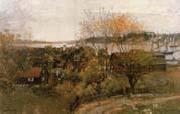 |
Alfred Wahlberg -- Click Here
|
|
1834-1906,Swedish painter. He received some tuition in drawing at the Royal Academy of Arts in Stockholm, although he was never formally enrolled as a student. In 1857 he went to D?sseldorf where he was a student of Hans Fredrik Gude. Swedish Landscape, Kolm?rden (1866; Stockholm, Nmus.) is representative of Wahlberg's D?sseldorf period. After a journey to the Netherlands and Belgium he returned to Stockholm in 1862 and became a member of the circle of artists around Karl XV. |
|
|
|
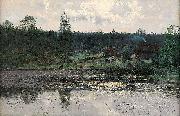 |
Alfred Thorne -- Click Here
|
|
painted Insjolandskap med gard in 1886 |
|
 |
Alfred Thompson Bricher -- Click Here
|
|
1837-1908
Alfred Thompson Bricher (born in Portsmouth, New Hampshire on April 10, 1837; died in Staten Island, New York on September 30, 1908) was a painter associated with White Mountain art and the Hudson River School.
He began as a businessman in Boston, Massachusetts before becoming a professional painter. He studied at the Lowell Institute when not working. He also studied with Albert Bierstadt, William Morris Hunt, and others In 1868 he moved to New York City and in the 1870s primarily did maritime themed paintings.
|
|
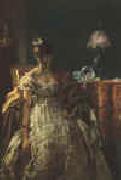 |
Alfred Stevens -- Click Here
|
|
1823-1906
Alfred Stevens Galleries
Flemish
Alfred Emile Stevens (May 11, 1823 - August 29, 1906) , Belgian painter, was born in Brussels.
El??gants sur les BoulevardsHis father, an old officer in the service of William I of the Netherlands, was passionately fond of pictures, and readily allowed his son to draw in the studio of François Navez, director of the Brussels Academy.
In 1844 Stevens went to Paris and worked under the instructing of Camille Roqueplan, a friend of his father's; he also attended the classes at the Ecole des Beaux-Arts, where Ingres was then professor. In 1849 he painted at Brussels his first picture, A Soldier in Trouble, and in the same year went back to Paris, where he definitely settled, and exhibited in the Salons. He then painted Ash-Wednesday Morning, Burghers and Country People finding at Daybreak the Body of a Murdered Gentleman, An Artist in Despair, and The Love of Gold.
Allegory of the Night
MSK, Oostende, BelgiumIn 1855 he exhibited at the Antwerp Salon a little picture called At Home, which showed the painter's bent towards depicting ladies of fashion. At the Great Exhibition in Paris, 1855, his contributions were remarkable, but in 1857 he returned to graceful female subjects, and his path thenceforth was clear before him. At the Great Exhibition of 1867 he was seen in a brilliant variety of works in the manner he had made his own, sending eighteen exquisite paintings; among them were the Lady in Pink (in the Brussels Gallery), Consolation, Every Good Fortune, Miss Fauvette, Ophelia, and India in Paris.
At the Paris International Exhibitions of 1878 and 1889, and at the Historical Exhibition of Belgian Art, Brussels, 1880, he exhibited The Four Seasons (in the Palace at Brussels), The Parisian Sphinx, The Japanese Mask, The Japanese Robe, and The Lady-bird (Brussels Gallery).
"Alfred Stevens is one of the race of great painters," wrote Camille Lemonnier, "and like them he takes immense pains with the execution of his work." The example of his finished technique was salutary, not merely to his brethren in Belgium, but to many foreign painters who received encouragement from the study of his method. The brother of Alfred Stevens, Joseph Stevens, was a great painter of dogs and dog life. See J. du Jardin, L'Art flamand; Camille Lemonnier, Histoire des beaux arts en Belgique.
|
|
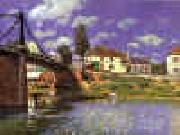 |
Alfred Sisley -- Click Here
|
|
French
1839-1899
Alfred Sisley Galleries
Alfred Sisley (October 30, 1839 ?C January 29, 1899) was an English Impressionist landscape painter who was born and spent most of his life in France. Sisley is recognized as perhaps the most consistent of the Impressionists, never deviating into figure painting or finding that the movement did not fulfill his artistic needs.
Sisley was born in Paris to affluent English parents; William Sisley was in the silk business, and his mother Felicia Sell was a cultivated music connoisseur. At the age of 18, Sisley was sent to London to study for a career in business, but he abandoned it after four years and returned to Paris. Beginning in 1862 he studied at the atelier of Swiss artist Marc-Charles-Gabriel Gleyre, where he became acquainted with Fr??d??ric Bazille, Claude Monet, and Pierre-Auguste Renoir. Together they would paint landscapes en plein air (in the open air) in order to realistically capture the transient effects of sunlight. This approach, innovative at the time, resulted in paintings more colorful and more broadly painted than the public was accustomed to seeing. Consequently, Sisley and his friends initially had few opportunities to exhibit or sell their work. Unlike some of his fellow students who suffered financial hardships, Sisley received an allowance from his father??until 1870, after which time he became increasingly poor. Sisley's student works are lost. His earliest known work, Lane near a Small Town is believed to have been painted around 1864. His first landscape paintings are sombre, coloured with dark browns, greens, and pale blues. They were often executed at Marly and Saint-Cloud. |
|
 |
Alfred Seifert -- Click Here
|
|
(September 6, 1850 Praskolesy, Bohemia - February 6, 1901, Munich, Germany) was a Czech-German painter, famous for his female portraits.
He was born in Praskolesy (present-day Czech Republic) but within a few months, his family moved to nearby Hořovice.
As a child, he fell seriously ill, could not walk for four years and spent two years in an orthopedic institution. Instead of playing, he started to draw pictures and his artistic talent soon started to emerge. His first teachers were Karel Werbs, inspector of Estates Gallery at Prague Castle, and Alois Kirnig, landscape painter. |
|
 |
Alfred Sacheverell Coke -- Click Here
|
|
fl.1869-1893
|
|
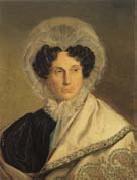 |
Alfred Rethel -- Click Here
|
|
1816 Diepenbend/Aachen-1859 Dusseldorf, was a German history painter. Rethel was born in Aachen in 1816. He showed an interest in art in his early life, and at the age of thirteen he executed a drawing which procured his admission to the academy of D??sseldorf. Here he studied for several years, and produced, among other works, a figure of St Boniface, which attracted much attention. At the age of twenty, Rethel moved to Frankfurt, and was selected to decorate the walls of the imperial hall in the Rmer with figures of famous men. At the same period he produced a series of designs illustrative of Old Testament history. Four years later, Rethel was the successful competitor for the work of ornamenting the restored council house of his native city with frescoes depicting prominent events in the career of Charlemagne, but the execution of this work was delayed for some six years. Meanwhile Rethel occupied himself with the production of easel pictures and of drawings. In 1842, he began a striking series of designs dealing with the Crossing of the Alps by Hannibal, in which the weird power which animates his later art becomes first apparent. In 1844 Rethel visited Rome, executing, along with other subjects, an altar-piece for one of the churches of his native land. In 1846, he returned to Aachen, and commenced his Charlemagne frescoes. |
|
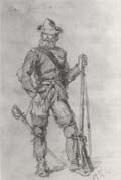 |
Alfred R. Waud -- Click Here
|
|
American, 1828-1891,was an American artist and illustrator, born in London, England. He is most notable for the sketches he made as an artist correspondent during the American Civil War. Before emigration, Alfred Waud had entered the Government School of Design at Somerset House, London, with the intention of becoming a marine painter. This did not come to fruition, but as a student, he also worked as a painter of theatrical scenery. He intended to pursue that work in the United States, when he immigrated in 1850, seeking employment with actor and playwright John Brougham. In the 1850s, he worked variously as an illustrator for a Boston periodical, the Carpet-Bag, and provided illustrations for books such as Hunter's Panoramic Guide from Niagara to Quebec (1857). The period during the American Civil War was time when all images in a publication had to be hand drawn and engraved by skilled artist. Photography existed but there was no way to transfer a photograph to a printing plate since this was well before the advent of the halftone process for printing photographs. Photographic equipment was too cumbersome and exposure times were to slow to be used on the battlefield. An artist such as Waud would do detailed sketches in the field, which were then rushed by courier back to the main office of the newspaper they were working for. There a staff of engravers would use the to sketches create finished engravings for publication. In 1860 Alfred Waud became an illustrator or special artist (a full time paid staff artist) for the New York Illustrated News. In April 1861, the newspaper assigned Waud to cover the Army of the Potomac, Virginia main Union army. He first illustrated General Winfield Scott in Washington, D.C., and then entered the field to render the First Battle of Bull Run in July. Waud followed a Union expedition to Cape Hatteras, North Carolina the next month. That autumn, he sketched army activity in the Tidewater region of Virginia. Waud joined Harper's Weekly toward the end of 1861, continuing to cover the war. In 1864 Alfred brother, William Waud (who up to that time had been working with Frank Leslie Illustrated Newspaper), joined Alfred on the staff of Harper's and they worked together during the Petersburg Campaign. Alfred Waud attended every battle of the Army of the Potomac between the First Battle of Bull Run in 1861 and the Siege of Petersburg in 1865. Alfred was one of only two artists present at the Battle of Gettysburg. His depiction of Pickett Charge is thought to be the only visual account by an eyewitness. Waud died in 1891 in Marietta, Georgia, while touring battlefields of the South. |
|
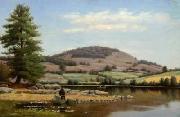 |
Alfred Ordway -- Click Here
|
|
(1821 - 1897) was an American landscape and portrait painter, and one of the founding fathers of the Boston Art Club.
Alfred was born in Roxbury, Massachusetts to mother Currier, and father Thomas Ordway on March 9, 1821. With his father being the cities' clerk, Alfred spent the majority of his childhood in Lowell, Massachusetts. His family can be traced back to the early 17th century when James Ordway settled in Dover, New Hampshire. Both his parents fought in the Revolutionary War, and his grandfather, Nehemiah Ordway, a physician in Amesbury, Massachusetts, was put in charge "to form and equip a company for Bunker Hill". |
|
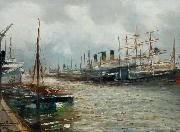 |
Alfred Jensen -- Click Here
|
|
painted Dalmannkai Hamburg. in Date probably 1897 |
|
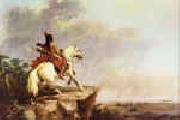 |
Alfred Jacob Miller -- Click Here
|
|
American Painter, 1810-1874
1810?C74, American artist, b. Baltimore, studied under Thomas Sully and in Europe. In 1837 he joined an expedition to the American West and was probably the first artist to depict the Rocky Mts. On that trip he produced his most important works, chiefly studies of Native American and frontier life, valuable for their documentary detail. These sketches and watercolors were entirely forgotten for nearly a century until they were rediscovered in a storeroom of the Peale Museum, Baltimore. |
|
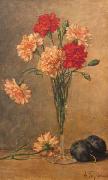 |
Alfred Hirv -- Click Here
|
|
(born March 26, 1880 in Pechory - died May 26, 1918 in Pskov) was an Estonian painter, known especially for his still lifes. For a time he studied with Julius von Klever in Saint Petersburg; further studies took him to Rome and Munich, where he studied at the school of Anton Ažbe. His paintings are reminiscent of the style of the Dutch Golden Age. Works by Hirv can be found in the Estonian Art Museum.
|
|
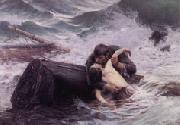 |
Alfred Guillou -- Click Here
|
|
French Academic Painter, 1844-1926 |
|
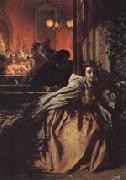 |
Alfred Elmore -- Click Here
|
|
Irish-born British Painter, 1815-1881
was a Victorian history and genre painter. He was born in Cork, Ireland, the son of Dr. John Richard Elmore, a surgeon who retired from the British Army to Clonakilty. His family moved to London, where Elmore studied at the Royal Academy of Arts. His early works were in the troubadour style of Richard Parkes Bonington, but he soon graduated to religious work, notably The Martyrdom of Thomas Becket, commissioned by Daniel O'Connell for Westland Row Church in Dublin. Between 1840 and 1844 Elmore travelled across Europe, visiting Munich, Venice, Bologna, and Florence. Elmore seems to have been associated with The Clique, a group of young artists who saw themselves as followers of Hogarth and David Wilkie. According to his friend William Powell Frith he was member of the group, but since it was most active while he was in continental Europe, his involvement was probably short-lived. Most of Elmore's later works were historical narrative paintings. Religious Controversy and The Novice were implicitly anti-Catholic in character. Other paintings set episodes from Shakespeare, or the history of the French Revolution. They often contained subtle explorations of the process of creation, most importantly his two paintings about technological innovation, The Invention of the Stocking Loom (1847, Nottingham Castle Museum) and The Invention of the Combing Machine (1862, Cartwright Hall, Bradford). Both portray the process of industrialisation by depicting picturesque pre-industrial handicrafts. The inventor is supposed to be pondering these manual skills while he forms in his mind a mechanism to replace them. Elmore's best-known work is On the Brink (1865; Fitzwilliam Museum, Cambridge), a moral genre painting depicting a young woman who has lost her money gambling, and is 'on the brink' of responding to the blandishments of a seducer, who is depicted as a satan-like figure, |
|
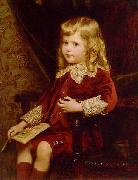 |
Alfred Edward Emslie -- Click Here
|
|
Alfred Edward Emslie (1848 London -1918) was an English genre and portrait painter, and photographer, living at The Studio, 34, Finchley Road, N. W.
He was the son of the engraver, John Emslie, and brother of John Phillipps Emslie, the figure painter. Married to miniature painter Rosalie M. Emslie, they had a daughter, Rosalie Emslie, who became a figure, portrait and landscape painter. Emslie turned increasingly to portraiture later in life. He had a great passion for the Orient, and spent three months exploring Japan. He was a elected an associate of the Royal Society of Painters in Water Colours in 1888 and a member of the Royal Society of Portrait Painters in 1892.
|
|
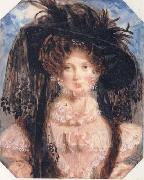 |
Alfred Eduard Chalon -- Click Here
|
|
British , (1780-1860) |
|
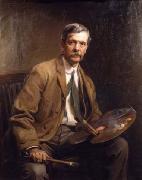 |
Alfred East -- Click Here
|
|
(December 15, 1849 C September 28, 1913) was an English painter.
He was born in Kettering in Northamptonshire and studied at the Glasgow School of Art. His romantic landscapes show the influence of the Barbizon school. His The Art of Landscape Painting in Oil Colour was published in 1906. In April 1888 he had shared an exhibition at the galleries of the Fine Art Society with T.C. Gotch and W. Ayerst Ingram, and was commissioned the following year by Marcus Huish, Managing Director of the Society, to spend six months in Japan to paint the landscape and the people of the country. When the exhibition of 104 paintings from this tour was held at the Fine Art Society in 1890 it was a spectacuar success. He was awarded a Knighthood in 1910 by King Edward VII. His portrait was painted by Philip de Laszlo. On Sunday, 28 September 1913, Alfred East died at his London residence in Belsize Park. |
|
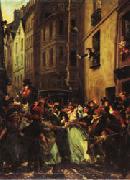 |
Alfred Dehodencq -- Click Here
|
|
French Painter. Paris 1822 - Paris 1882. Specializes in Orientalism. French painter born in Paris. Well known for his vivid oil paintings depicting slices of life in the world around him. During his early years , Dehodencq studied in Paris at the Ecole des Beaux Arts under the tutelage of famous French artist Leon Cogniet. Following the French revolution of 1848 he spent five years in Spain where he became acquainted with the works of Spanish painters Diego Vel??zquez and Francisco Goya which had a strong influence on his approach to painting. In 1853 he travelled to Morocco where for the following ten years he produced many of his most famous paintings depicting scenes of the world he encountered. While he considered himself to be a 'Last of the Romantics', his work is generally categorized in the mid 19th century realists artistic movement. Dehodencq was the first foreign artist known to have lived in Morocco for an extended number of years. He returned to Paris in 1863. He died in 1882 |
|
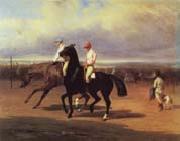 |
Alfred Dedreux -- Click Here
|
|
1810-1860,French painter and draughtsman. His father was the architect Pierre-Anne Dedreux (1788-1849); Alfred's sister, Louise-Marie Becq de Fouqui?res (1825-92), was also an artist. His uncle, Pierre-Joseph Dedreux-Dorcy (1789-1874), a painter and intimate friend of Gericault, took Dedreux frequently to the atelier of Gericault whose choice of subjects, especially horses, had a lasting influence on him. During the 1820s he studied with L?on Cogniet, although his early style was more influenced by the work of Stubbs, Morland, Constable and Landseer, exposure to which probably came through Gericault and the painter Eugene Lami who lived in London in the mid-1820s. |
|
|
|
|
|
|
|
|
|
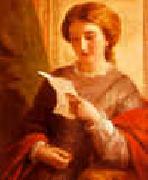 |
Alfred Chalon -- Click Here
|
|
English 1780-1860
Swiss-British painter and illustrator. Much of what we know about the look of romantic ballet is owed to his lithographs and illustrations. He was Taglioni portraitist and his 1845 lithograph of the Pas de quatre, with Carlotta Grisi, Marie Taglioni, Lucile Grahn, and Fanny Cerrito, is one of the most famous images in all dance. |
|
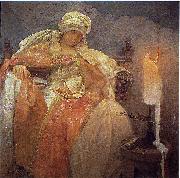 |
Alfons Mucha -- Click Here
|
|
known in English as Alphonse Mucha, was a Czech Art Nouveau painter and decorative artist, known best for his distinct style. He produced many paintings, illustrations, advertisements, postcards, and designs.
Alphonse Maria Mucha was born in the town of Ivančice, Moravia (the present Czech Republic). Although his singing abilities allowed him to continue his education through high school in the Moravian capital of Brno, drawing had been his main hobby since childhood. He worked at decorative painting jobs in Moravia, mostly painting theatrical scenery. During 1879, he relocated to Vienna to work for a major Viennese theatrical design company, while informally augmenting his artistic education. When a fire destroyed his employer's business during 1881 he returned to Moravia, to do freelance decorative and portrait painting. Count Karl Khuen of Mikulov hired Mucha to decorate Hrušovany Emmahof Castle with murals, and was impressed enough that he agreed to sponsor Mucha's formal training at the Munich Academy of Fine Arts.
|
|
|